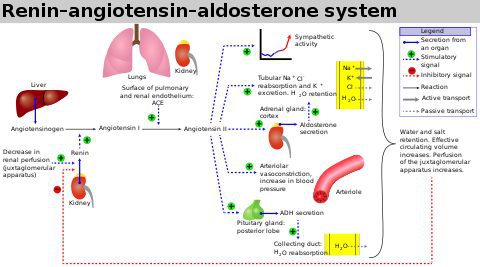Contents
Angiotensin
Angiotensins I and II are proteins of the renin-angiotensin-aldosterone system, a hormonal system located in the kidney whose role is to regulate blood pressure in the body. Hormonal disturbances may be involved in heart failure and primary hyperaldosteronim. And the production of angiotensin II may be a risk factor for atherosclerosis.
Definition of angiotensin
Angiotensins I or II are polypeptides, in other words proteins made up of a chain of amino acids, which circulate in the blood.
These two polypeptides are made by the body through a succession of enzymatic reactions from angiotensiogen, an inactive protein produced in the liver. Angiotensins I and II are part of the renin-angiotensin-aldosterone system, a hormonal system located in the kidney whose role is to regulate blood pressure in the body.
Functions of angiotensin
Angiotensin I and II are produced by the body in response to a decrease in blood pressure. They are made in a series of enzymatic reactions from angiotensiogen, an inactive protein produced in the liver.
When blood pressure drops, the kidneys release an enzyme called renin into the blood. The latter will separate the angiotensiogen into several pieces. One of the fragments is angiotensin I, an inactive protein. Angiotensin I will in turn be cut into several fragments under the action of the angiotensin converting enzyme (ACE), an enzyme secreted by the lungs. One of the fragments is angiotensin II, a very active protein with the following effects:
Vasoconstriction
Angiotensin II causes the muscle walls of the small arteries to constrict. This decrease in the size of the blood vessels leads to an increase in blood pressure.
Secretion of aldosterone
Angiotensin II causes an increase in the secretion of aldosterone by the adrenal glands. Aldosterone is a hormone which acts on the reabsorption of sodium in the kidney (part of the sodium contained in the blood which arrives at the kidney to be filtered is reabsorbed by the arteries). As water always follows sodium in internal media, aldosterone also induces water retention, and therefore an increase in blood pressure.
Secretion of vasopressin
Angiotensin II also stimulates the secretion of vasopressin in the pituitary gland. Vasopressin is a hormone which increases the tone of the blood vessels and decreases the volume of urine. It therefore leads to an increase in water retention, and therefore an increase in blood pressure.
Anomalies / Pathologies
Angiotensins are particularly involved in hormonal disorder pathologies that involve the renin-angiotensin-aldosterone system:
Crohn’s syndrome
Also called primary hyperaldosteronism, Crohn’s syndrome is a cause of high blood pressure. It is due to the excessive and autonomous production of aldosterone by the adrenal cortex. Primary hyperaldosteronism is due to hyperplasia, adenoma, or carcinoma. It is manifested in particular by a sodium concentration in the body that is too high (hypernatremia) and too much blood volume (hypervolemia). The associated symptoms are episodes of severe fatigue, paresthesias, transient paralysis and tetany.
Heart failure
When cardiac function deteriorates, renal blood flow decreases (due to low cardiac output) which activates the renin-angiotensin-aldosterone system and leads to a cascade of potentially deleterious effects. For example, vasoconstriction triggered by angiotensin II worsens heart failure.
The production of angiotensin II can also be a risk factor for certain pathologies:
Atherosclerosis
Atherosclerosis is a disease in which fatty deposits form in the walls of the arteries causing decreased or blocked blood flow. It is favored when the body is subjected to oxidative stress, in other words in the presence of too large a quantity of oxidizing species against which the body can no longer defend itself. However, angiotensin II stimulates the production of several oxidizing species such as superoxide ions and hydrogen peroxide.
Treatments
Crohn’s syndrome
If there is a tumor, it can be removed surgically. In hyperplasia, hyperaldosteronism can be controlled with antialdosterones such as spironolactone.
Heart failure
Drug treatment for heart failure includes:
- ACE inhibitors stop the process of formation of angiotensin II whose concentration in the blood decreases. This leads to an increase in the diameter of the blood vessels, a drop in blood pressure and a decrease in the work done by the heart.
- Angiotensin II receptor blockers block the action of angiotensin II
- Β-blockers enhance the action of the two previous drugs
Atherosclerosis
Treatment requires changes in risk factors, including lifestyle changes (diet, smoking cessation, regular physical activity). Medicines used to treat certain disorders that can contribute to the development of atherosclerosis (abnormal levels of lipids in the blood, high blood pressure, diabetes) are often necessary. In some cases, ACE inhibitors and β-blockers may be prescribed.










